Miami
by
Philip Greenspun
Home : Travel : Costa Rica : One Part
Costa Rica? Why Costa Rica? A lot of friends were
asking. "Because everyone who comes back has nice things to say," I'd respond.
"It is kind of like New Zealand in that respect." I tried to sound cavalier,
but the truth was that I didn't have any idea what the country was like, had a
crushing work schedule in December and January that left no time for plans or
reading, and didn't speak any Spanish. I didn't even want to go, but my
girlfriend Chantal had said "there is no way that I'm staying in Boston for
January" so we stayed up all night packing and straggled into the airport at
8:40 for the 9 a.m. flight to Miami.
January 13, 1995
 They call Miami the "Capital of Latin America" and its reach extends all
the way to the gate at Logan Airport. As soon as I got on the plane, I was
surrounded by Spanish-speakers. An older woman asked me in Spanish to help her
getting a suitcase back out of an overhead compartment. She struggled for an
English "thank you" for a moment, then gave up and said "Gracias."
They call Miami the "Capital of Latin America" and its reach extends all
the way to the gate at Logan Airport. As soon as I got on the plane, I was
surrounded by Spanish-speakers. An older woman asked me in Spanish to help her
getting a suitcase back out of an overhead compartment. She struggled for an
English "thank you" for a moment, then gave up and said "Gracias."
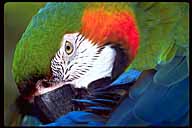 Because of their staggering import duties, Latin Americans are fond of Korean
vehicles. Dollar Rent-A-Car makes them feel right at home with its fleet of
Hyundais. Chantal and I drove straight south to Parrot Jungle, where parrots
will take food from your hand, kiss you, and climb on your head and arms if
Ramon asks them nicely.
Because of their staggering import duties, Latin Americans are fond of Korean
vehicles. Dollar Rent-A-Car makes them feel right at home with its fleet of
Hyundais. Chantal and I drove straight south to Parrot Jungle, where parrots
will take food from your hand, kiss you, and climb on your head and arms if
Ramon asks them nicely.
"I came here from Cuba eight years ago," Ramon explained. "I expected to stay
two months, but I've been here at Parrot Jungle the whole time."
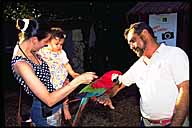
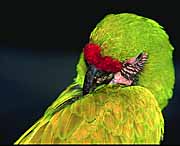
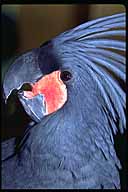
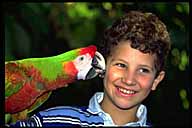
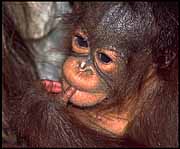
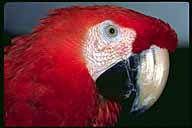
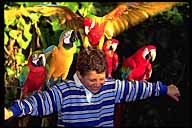
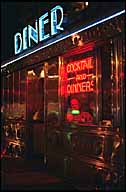 We weren't quite ready to immerse ourselves in the Latin American culture, so
we drove over the causeway from downtown Miami onto Miami Beach, an entirely
separate city on its own collection of islands. The Art Deco district here is
a favorite of European travelers, fashion photographers, and yuppies. Mostly
these folks congregate right up against the beach. If you go back just a few
blocks, you'll find residential hotels filled with Jewish New Yorkers who
retired into poverty from miserable Garment District jobs. Go a few blocks
south and you'll find the human remnants of the 1980 Mariel boatlift, when
125,000 Cubans came over (many of them former residents of Cuban prisons and
mental hospitals).
We weren't quite ready to immerse ourselves in the Latin American culture, so
we drove over the causeway from downtown Miami onto Miami Beach, an entirely
separate city on its own collection of islands. The Art Deco district here is
a favorite of European travelers, fashion photographers, and yuppies. Mostly
these folks congregate right up against the beach. If you go back just a few
blocks, you'll find residential hotels filled with Jewish New Yorkers who
retired into poverty from miserable Garment District jobs. Go a few blocks
south and you'll find the human remnants of the 1980 Mariel boatlift, when
125,000 Cubans came over (many of them former residents of Cuban prisons and
mental hospitals).
One of my favorite restaurants in the area is Lulu's which serves southern food
in huge portions to hungry fashion models.

South Beach: The Art Deco District
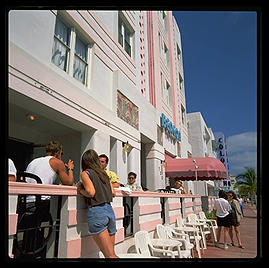
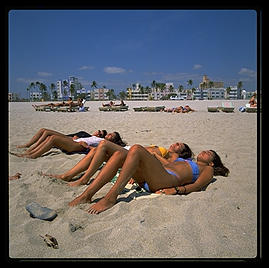
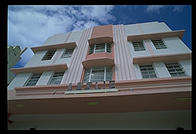
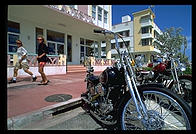
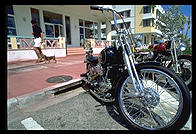
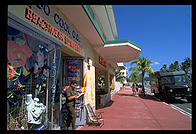
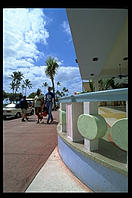
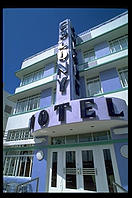
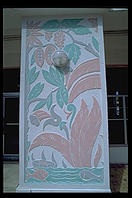
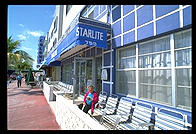
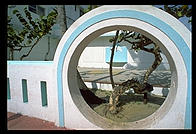
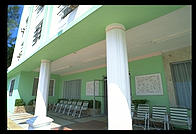
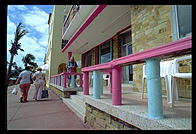
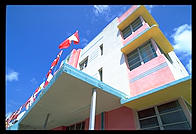
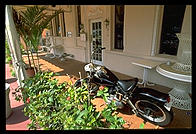
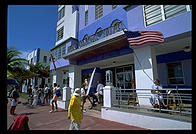
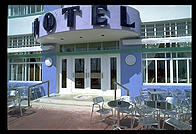
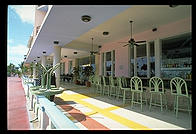
Saturday, January 14, 1995
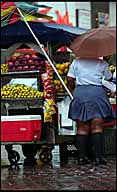 Henry Flagler created modern Florida by building a railroad to Palm
Beach in 1885. After a frost destroyed most of the state's crops in 1895,
Flagler decided to extend the railroad southward and built the city of Miami at
the new end of the line. The street that bears his name, Flagler Street, is
the main shopping and cultural drag of downtown Miami. We stopped for a bite
at Cacique Lunch, a Cuban joint across the street from the art museum. We sat
down at the bar across from the owner, a Cuban of about 50 with a weathered
brown face. Elsia, an Ecuadorian, sat next to me. She's been coming here for
10 years, but never staying more than six months at a time.
Henry Flagler created modern Florida by building a railroad to Palm
Beach in 1885. After a frost destroyed most of the state's crops in 1895,
Flagler decided to extend the railroad southward and built the city of Miami at
the new end of the line. The street that bears his name, Flagler Street, is
the main shopping and cultural drag of downtown Miami. We stopped for a bite
at Cacique Lunch, a Cuban joint across the street from the art museum. We sat
down at the bar across from the owner, a Cuban of about 50 with a weathered
brown face. Elsia, an Ecuadorian, sat next to me. She's been coming here for
10 years, but never staying more than six months at a time.
"It is all I can take," she said. "I don't understand why Americans live the
way they do. Nobody talks to each other. They don't know their neighbors.
There are no little shops, just strips of huge stores then isolated houses with
isolated people with two TVs, three videos, and more stuff piled to the
ceiling. Coconut Grove used to be a beautiful place, with big trees and little
shops and everyone knew each other. Now they've built Coco Walk, another
shopping mall, and it is all ruined."
Her daughter has been here since she was 14 and married a Chilean. Had she
kept her Ecuadorian values or been seduced by materialism?
"She's become an American," Elsia sighed.
Elsia had the gracious Old World manners that you can't find in the Old World
anymore. She said everything once slowly in Spanish and then repeated in
English so that we'd be better prepared for Costa Rica. She also translated
for our Costa Rican waitress, who has lived in Miami for 15 years but never
learned much English.
Elsia showed us some snapshots of Quito and a small mountain town on the
equator. Like Bill Bryson, Elsia was looking for the perfect American small
town.
"I hear that Santa Fe is nice, that people have an appreciation for beauty,
architecture, and community."
Miami's main art museum is in the Metro-Dade Cultural Center, an elegant
complex of Spanish-architecture buildings. Its collection is strange and
small. Today they featured an exhibit of a Uruguayan gaucho painter and an
abstractionism exhibit full of hard-to-look-at paintings by famous artists.
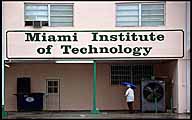 We drove west on Flagler and the neighborhood quickly deteriorated
into poverty. Although the commercial action on the street is lively,
some of the houses were boarded up and the people wore a defeated look
exacerbated by the persistent heavy rain. We stopped at a McDonald's
for sodas. One of the kitchen workers was having a smoke in the men's
room, which was filthy. The register clerk, a boy of about 18, was
delighted to have Anglo customers and spoke English to us very
carefully, almost reverently, rounding all the words. In back of the
McDonald's, I noticed the little-known southern branch campus of MIT.
We drove west on Flagler and the neighborhood quickly deteriorated
into poverty. Although the commercial action on the street is lively,
some of the houses were boarded up and the people wore a defeated look
exacerbated by the persistent heavy rain. We stopped at a McDonald's
for sodas. One of the kitchen workers was having a smoke in the men's
room, which was filthy. The register clerk, a boy of about 18, was
delighted to have Anglo customers and spoke English to us very
carefully, almost reverently, rounding all the words. In back of the
McDonald's, I noticed the little-known southern branch campus of MIT.
Feeling as though we'd done our bit to find high culture in Miami, we drove to
the Coco Walk shopping mall in Coconut Grove to see if Elsia was right.
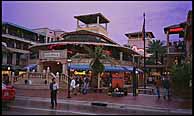 The place was jammed; we could barely get into the parking lot. It was filled
with beautiful people beautifully dressed. Muscular tanned guys, Latin women
in tiny black dresses, fancy sports cars. Appearance is everything here. We
had some truly terrible food at a beautiful looking Italian restaurant, Cafe
Med, on the ground floor of the mall, then milled around.
The place was jammed; we could barely get into the parking lot. It was filled
with beautiful people beautifully dressed. Muscular tanned guys, Latin women
in tiny black dresses, fancy sports cars. Appearance is everything here. We
had some truly terrible food at a beautiful looking Italian restaurant, Cafe
Med, on the ground floor of the mall, then milled around.
We found a Peruvian salesman in Banana Republic who really wanted to go back to
Peru and practice photography, but he hadn't managed to scrape up enough
money.
The only Anglo we managed to strike up a conversation with was there with his
gay partner. It occurred to me then that Miami wasn't exactly Reagan's
America.
I stopped at a nut and lemonade stand run by two handsome, cheerful guys, a
Peruvian and a Mexican. The Peruvian was very sorry to be here, but couldn't
go back because his father had too many enemies. I asked who was after him,
the government or the guerrillas?
"Both," he smiled.
In two days, we hadn't managed to find anyone who was happy living in Miami.
People came here to work or be with family, but they'd much rather be somewhere
else. It is kind of like Los Angeles.
Our hosts Molly and Warner echoed this theory. Molly finished her PhD at MIT
and the best job she could find was at a NOAA lab on Key Biscayne, an island
connected by causeway to Miami. Warner hadn't been too enthusiastic about
leaving his job at Digital.
"My main problem was that everyone who didn't have a direct interest in our
coming here said not to make the move. We went to look at one house and the
owner said `Oh, I hate it here. I've lived here for fifteen years and hated
every one.' I couldn't find anyone who'd grown up in Miami and I couldn't find
anyone who liked it here."
"Well," Molly added, "the people who are happy are those who have some
water-based activity that they just love to do, like deep-sea fishing. Most of
the people in my lab are like that."
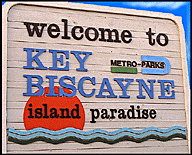 They'd settled down on Key Biscayne, which became famous when
President Nixon would come here to his house next to mobster/banker
pal Bebe Rebozo (who allegedly kept $100,000 of Howard Hughes's cash
for Nixon). The island has changed a bit since
then.
They'd settled down on Key Biscayne, which became famous when
President Nixon would come here to his house next to mobster/banker
pal Bebe Rebozo (who allegedly kept $100,000 of Howard Hughes's cash
for Nixon). The island has changed a bit since
then.
"When we moved in," Molly explained, "the Colombian family next door tried
their best to be hospitable. `Oh, you'll love this neighborhood. There's an
American three houses down Harbor Drive, and an American two blocks up
Beechwood, and...' Practically the whole Key is owned by South Americans.
Houses go for $500,000 on the interior to a few million dollars on the water,
but prices aren't a problem when you collect the wealth of an entire
continent."
January 15
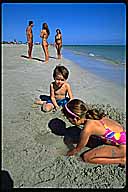 Molly and Warner showed us around the beach clubs, condos, state park,
and luxury neighborhoods of "The Island Paradise of Key Biscayne." Hurricane
Andrew was two years ago and even a wealthy community like Key Biscayne hasn't
managed to rebuild completely. The state park around the old lighthouse at the
southern tip of the key was the worst hit. It used to be covered with 30 foot
high palm trees, but now is a wasteland of scrub and young trees held up by
stakes and guy wires.
Molly and Warner showed us around the beach clubs, condos, state park,
and luxury neighborhoods of "The Island Paradise of Key Biscayne." Hurricane
Andrew was two years ago and even a wealthy community like Key Biscayne hasn't
managed to rebuild completely. The state park around the old lighthouse at the
southern tip of the key was the worst hit. It used to be covered with 30 foot
high palm trees, but now is a wasteland of scrub and young trees held up by
stakes and guy wires.
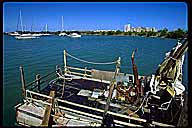 As we rounded the park bike path, we came upon a tiny harbor filled with
gleaming white sailboats, power yachts and a strange little catamaran. The
catamaran consisted of a plywood deck surrounded by a makeshift wooden railing.
A tattered sail and a rusty car engine were the power sources.
As we rounded the park bike path, we came upon a tiny harbor filled with
gleaming white sailboats, power yachts and a strange little catamaran. The
catamaran consisted of a plywood deck surrounded by a makeshift wooden railing.
A tattered sail and a rusty car engine were the power sources.
"That's a Cuban raft," said Molly. "See the Coast Guard numbers spray-painted
on? They did that so they'd know that they already took the guys off the raft
and wouldn't worry about them. So these folks didn't make it, although this
looks much better than the average raft."
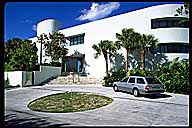 Back in the developed portion of the key, Molly displayed an eye for and
knowledge of real estate that would have done a California divorcée
proud. We even had to stop into an open house. The canal-front property might
have been nice before Andrew, but flood, mildew, standing water, and a warped
roof made me think that $1.1 million might be better spent.
Back in the developed portion of the key, Molly displayed an eye for and
knowledge of real estate that would have done a California divorcée
proud. We even had to stop into an open house. The canal-front property might
have been nice before Andrew, but flood, mildew, standing water, and a warped
roof made me think that $1.1 million might be better spent.
 We crossed a bridge onto Virginia Key, passed Molly's lab and a University of
Florida lab, then biked down to Jimbo's. Jimbo quietly smokes fish out back
with the manatees while the front of the shack hops with activity. Six
production companies had been there in the morning and two were still there. A
bunch of wooden buildings are done up in Western or Art Deco colors depending
upon the shoot. We watched Renee Anderson croon a pop melody in front of a
bunch of mounted game fish while the cameras rolled. We also talked to Reuben,
a trim production manager, about the beautiful women and ugly clothes on
display.
We crossed a bridge onto Virginia Key, passed Molly's lab and a University of
Florida lab, then biked down to Jimbo's. Jimbo quietly smokes fish out back
with the manatees while the front of the shack hops with activity. Six
production companies had been there in the morning and two were still there. A
bunch of wooden buildings are done up in Western or Art Deco colors depending
upon the shoot. We watched Renee Anderson croon a pop melody in front of a
bunch of mounted game fish while the cameras rolled. We also talked to Reuben,
a trim production manager, about the beautiful women and ugly clothes on
display.
"It's for a German catalog. The models are all hired locally, but the clothes
and the photographers come from Germany. I'm here to get permits, pay taxes,
and make sure everything runs smoothly."
Reuben grew up in Germany, but has lived in Miami for many years.
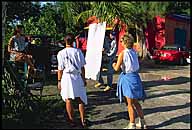 "Really, I don't notice the women. I'm working too hard. Except sometimes,"
as we both craned our necks toward the beautiful Spanish-boned model 30 feet from
the business end of a Nikon 600/4. The photographer behind the camera shouted
"I love it" in arty German-accented English and pantomimed poses.
"Really, I don't notice the women. I'm working too hard. Except sometimes,"
as we both craned our necks toward the beautiful Spanish-boned model 30 feet from
the business end of a Nikon 600/4. The photographer behind the camera shouted
"I love it" in arty German-accented English and pantomimed poses.
Monday, January 16, 1995
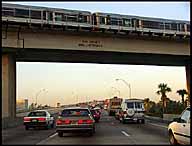 Interstate 95 connects to the Miami airport via a six-lane Dolphin
Expressway. Today was Martin Luther King Day, a federal and state holiday, so
we expected light traffic at 7 a.m. We didn't count on a fatal accident that
completely closed the expressway and left thousands of cars parked with their
engines off. It made for decent photography at times, but we got to the
American Airlines counter only 15 minutes before our 9 a.m. flight.
Interstate 95 connects to the Miami airport via a six-lane Dolphin
Expressway. Today was Martin Luther King Day, a federal and state holiday, so
we expected light traffic at 7 a.m. We didn't count on a fatal accident that
completely closed the expressway and left thousands of cars parked with their
engines off. It made for decent photography at times, but we got to the
American Airlines counter only 15 minutes before our 9 a.m. flight.
 "It is too late for an international flight," the Anglo supervisor explained
curtly.
"It is too late for an international flight," the Anglo supervisor explained
curtly.
"But we sat in traffic for an hour. There was an accident on the Dolphin
Expressway. Didn't you hear?"
"There are accidents every day. Tough luck."
By the time we'd worked our way to the front of the huge line, it was about
9:15.
"You know, you've missed your nine o'clock plane," our Ecuadorian ticket agent
politely noted.
We explained the situation.
"That's a real shame, because they could have gotten you on. I'm going to give
you one of the last seats on the eleven o'clock."
We didn't leave until noon because they were having such a tough time getting
all the baggage onto the plane. Miami is the shopping capital of Latin America
and every family returning to Central and South America seems to be trying to
check through a refrigerator or washing machine.
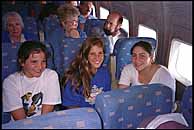
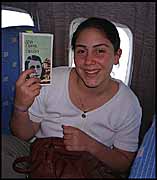 The third Miami inescapable (after the Spanish language and mildew) is the
Holocaust. Most of the older Jews who've retired in Florida remember relatives
who were killed and the Miami Herald ran a front-page story in their Sunday
edition about "Auschwitz Memories 50 Years Later." Once again the reach of
Miami culture extends to the airplanes serving the city. Three high school
girls from Argentina, fresh from Disneyworld, were sitting behind me and one
was reading the Diary of Anne Frank in a Spanish translation [Anne Frank
was actually killed in Bergen-Belsen, not Auschwitz].
The third Miami inescapable (after the Spanish language and mildew) is the
Holocaust. Most of the older Jews who've retired in Florida remember relatives
who were killed and the Miami Herald ran a front-page story in their Sunday
edition about "Auschwitz Memories 50 Years Later." Once again the reach of
Miami culture extends to the airplanes serving the city. Three high school
girls from Argentina, fresh from Disneyworld, were sitting behind me and one
was reading the Diary of Anne Frank in a Spanish translation [Anne Frank
was actually killed in Bergen-Belsen, not Auschwitz].
Look at a map of Central America
(with our flight's approximate route marked in pink) (85K GIF)
 Continue on to the Central Valley of Costa Rica
Continue on to the Central Valley of Costa Rica
philg@mit.edu
Add a comment | Add a link
 They call Miami the "Capital of Latin America" and its reach extends all
the way to the gate at Logan Airport. As soon as I got on the plane, I was
surrounded by Spanish-speakers. An older woman asked me in Spanish to help her
getting a suitcase back out of an overhead compartment. She struggled for an
English "thank you" for a moment, then gave up and said "Gracias."
They call Miami the "Capital of Latin America" and its reach extends all
the way to the gate at Logan Airport. As soon as I got on the plane, I was
surrounded by Spanish-speakers. An older woman asked me in Spanish to help her
getting a suitcase back out of an overhead compartment. She struggled for an
English "thank you" for a moment, then gave up and said "Gracias."







































